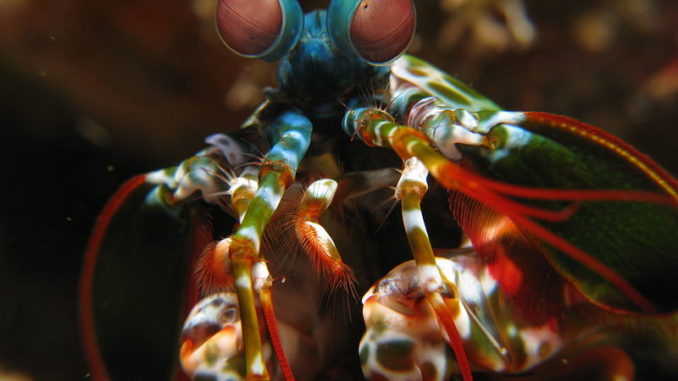
When great vision is mentioned some people think of large raptors streaking toward prey from hundreds of feet in the air, while others call to mind classical philosophers and founders of nations. Biologists… they think of shrimp. Mantis shrimp, to be precise.
Their eyes are split into three zones, with compound eyes on top and bottom and a strip in the middle which allows for more precise image development. The result is something akin to a pixelated top and bottom for an image with a horizontal center band. In theory this would less effective, not more, than the vision of many other creatures. Then come the extras…
The cone cells in human eyes recognize red, blue and green colors, and the different levels of each allow our brains to process hundreds of gradients of hue associated to the mixtures of each. Some animals’ eyes are able to recognize other colors, and even ultraviolet bands. Typically, those creatures will still have three (on rare occasions, four) wavelengths they can detect, which means that an animal might not recognize reds or greens but could see somewhat into the ultraviolet spectrum. A mantis shrimp? It sees twelve.
Because of the compound eyes, the extra color receptors aren’t initially as impressive as they might sound. To explain, imagine an old 8-bit character design… say, the original Mario from Donkey Kong and Super Mario Bros. It’s impossible to mistake that for a photograph because it lacks detail. The mantis shrimp eyes (with the exception of the center band) lack detail… what is happening with the color receptors is that the individual blocks can be colored in a variety of ways, not simply red, green and blue.
There is a purpose to it… but while it’s odd, it doesn’t seem very impressive. That changes a little bit when the eyes are then shown to be able to move independently and to detect parts of the ultraviolet spectrum and even polarized light.
The last item is what has sparked interest of researchers; by emulating the odd special vision of the mantis shrimp, cameras have been developed which, by examining polarized light images in real time, allow for early identification of cancer cells.
The ability to detect polarized light seems to be directly related to mating and territory. As the shrimp is looking for a mate, or angry, or pleased, portions of its body change the way it reflects light… allowing other mantis shrimp to know its intentions. The reason for the most of the color differentiation has nothing to do with shrimp interaction (or even cancer detection), though… it’s for speed.
The mantis shrimp is a predator, and it attacks just about anything. It has a punch that launches at about 50 mph, the fastest strike in the animal kingdom. It needs to be certain that it’s about to punch a breakable, vulnerable creature and not an unyielding rock. It also needs to be able to strike before its prey can retreat.
The color receptors in its eyes enable the shrimp to gather information about a nearby object and transfer the pixelated image, complete, to its brain. There’s none of the internal parsing and interpretation that brains normally do to translate an image into something recognizable; it just pops in immediately, all colored and ready to be acted upon… and that’s when the shrimp attacks. In the underwater world of the Great Barrier Reef, a few microseconds can mean the difference between dinner, or going hungry.
Question of the night: What’s your favorite shrimp dish?
